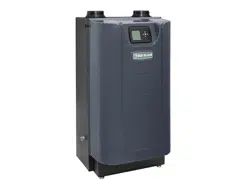Loading ...
Loading ...
Loading ...

3. Remove the air bae (item2) and screws (item4) from the
jacket top as shown.
1. See Figure 93, page98 (EVG 220 shown) for component
references below.
2. Disconnect the ground wire and ignition cable connected to
the ignition electrode assembly (item7).
3. Use a 3mm Allen wrench to remove the two (2) screws se-
curing the ignition electrode assembly to the heat exchanger
cover plate (item6).
4. Carefully remove the ignition electrode assembly from the
heat exchanger cover plate.
5. Discard the ignition electrode assembly gasket.
6. Inspect the ignition electrodes and ceramic insulators.
a. Remove any white oxides accumulated on the ignition
electrodes using steel wool.
b. Clean the gasket surfaces on the ignition electrode as-
sembly ange and on the mating surface of the heat
exchanger cover plate.
c. If the ignition electrode ceramic is cracked or damaged, or
if the electrodes cannot be cleaned satisfactorily, replace
the ignition electrode assembly with a new one.
7. Slide the new gasket onto the ignition electrode assembly.
8. Set the ignition electrode assembly with new gasket aside for
later re-insertion.
9. Check ignition cable electrical resistance.
a. A good cable will have resistance between 950 and 1050
ohms.
b. Replace cable if not acceptable.
10. Verify all wiring is in good condition and securely attached.
11. Inspect boiler ground wire from heat exchanger access cover
to ground terminal screw in control tray.
a. Check resistance. It should be 0 ohms.
b. Check ground continuity of wiring using continuity
meter.
c. Replace ground wires if results are not satisfactory.
1. See Figure 93, page98 (EVG 220 shown) for component
references below.
2. Disconnect the ame sense wire connected to the ame sense
rod (item8).
3. Use a 3mm Allen wrench to remove the two screws secur-
ing the ame sense rod assembly to the heat exchanger cover
plate. Carefully remove the ame sense rod.
4. Discard the ame sense rod gasket.
5. Inspect the ame sense rod and ceramic.
a. Remove any white oxides accumulated on the ame
sense rod.
b. Clean the gasket surfaces on the ame sense assembly
ange and on the mating surface of the heat exchanger
cover plate.
c. If the ame sense rod is bent or cannot be cleaned satis-
factorily or if the ceramic is cracked or damaged, replace
the ame sense rod assembly with a new one.
6. Slide the new gasket onto the ame sense rod assembly.
7. Inspect ame sense wire from ame sense connector to the
connector at the control module in boiler control tray.
a. Check resistance. It should be 0 ohms.
b. Replace Wire Harness– Low Voltage if results are not
satisfactory.
1. See Figure93,page98 (EVG220 shown).
2. Use a Phillips stubby screwdriver to remove the four (4) M4
screws (item10) that secure the burner access cover (item4)
to the heat exchanger cover plate (item6).
3. Remove the burner access cover (item4) and the burner
(item11).
Use caution when removing the burner to pull it
directly up and out. DO NOT angle the burner as
you remove it. Angling the burner could cause it to
strike the refractory, damaging the refractory and
causing fragments to fall into the heat exchanger.
Should this happen, a heat exchanger refractory
replacement kit must be installed and the heat ex-
changer must be thoroughly cleaned following the
procedures given in this manual and the refractory
replacement instructions.
4. Remove and discard the burner gasket (item12). is gasket
is graphite and may pull apart or stick to the burner on re-
moval. Use a so brush if necessary to remove residue. DO
NOT allow debris to drop into the heat exchanger. A new
gasket must be installed later when the burner is re-inserted.
5. Inspect the burner access cover seal (item13). Discard and
use a new seal during re-assembly if the seal is damaged in
any way.
6. Inspect the interior of the burner. Brush and vacuum the
interior if needed to remove lint or sediment. Alternative
cleaning methods:
a. Blow air or nitrogen from the inside out.
b. Clean with a water spray from inside the burner.
7. Inspect the burner exterior. It must be in good condition,
with no visible damage.
8. Clean the under side of the burner ange (see item15) with
a so brush to remove any gasket fragments remaining.
9. Set the burner aside for re-insertion later.
1. Look into the burner opening in the heat exchanger cover
plate.
2. Use a trouble light and inspection mirror to inspect the heat
exchanger interior.
a. Make sure that there is no debris inside the heat ex-
changer.
b. Use the inspection mirror to check the condition of the
burner refractory that is adhered to the bottom of the
heat exchanger cover plate. It must be in good condition
with no indication of damage or sagging.
Part number 550-100-211/0122
– 97 –
220 /29 9/3 00 /39 9
(continued)
Loading ...
Loading ...
Loading ...
